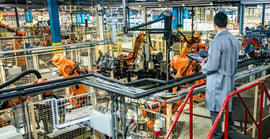
If you’re not convinced about the acceptance of automation in manufacturing, here are some stats to convince you:
- By 2022, 42% of total task hours will be completed by machines. (World Economic Forum)
- Nearly 70% of workers believe automation will bring opportunities for higher skilled work. (International Federation of Robotics)
- 24% of employers would automate jobs in order to reduce operating costs.
(Willis Towers Watson)
Of course, in 2020 we’ve all witnessed the power of a global pandemic and how it affects manufacturing. COVID-19 has wreaked havoc within supply chains as well as workforces.
Companies experiencing the advantages of automation have seen more success, while the others were exposed for their inefficiencies and reliance on manual processing and are now playing catch up. Because social distancing is the new norm, automation technology and other connected solutions keep operations up and running in work environments where physical labor alone cannot.
According to a Honeywell Intelligrated study, “the use of robotic technology, guided work solutions, and computer-controlled equipment is seen as very important by companies for future competitiveness.”
Because cost is the biggest barrier to further investment, the Research and Development (R&D) Tax Credit is seen as a great opportunity for companies to minimize their tax burden, free up operating capital, and implement automation. And for those that have already launched automation initiatives, they may qualify for the R&D Tax Credit, too.
In this article, we’ll take a closer look at what opportunities exist for manufacturers and, not only how the R&D Tax Credit can pay for them, but how the process itself can qualify as well.
Automation Saves Labor Costs
Yes, this is the biggie. Of course, a reduction of employee hours provides the highest ROI, but it also frightens workers who feel that they’re being replaced by robots. In reality, automation’s purpose is to eliminate non-value added activities, freeing up time for team members to do more meaningful, valuable work. Plus, they need to be designed, built, programmed and maintained as Industry 4.0 proceeds.
In one way or another, automation has been saving on labor costs for well over a century. Around 1900, the average worker put in about 70 hours per week. Because of automation and mechanization, however, it gradually required less and less hours to process a standard production order through a manufacturer.
Lastly, when it comes to labor cost savings, automation can be viewed as “disruption proofing” a business, so any future challenges can be handled more smoothly than many were this year. If anything, COVID-19 serves as an example of unpredictability that manufacturers need to be ready for in order to improve profitability and accelerate growth.
Automation Creates Less Waste
We’re sure your operators are highly skilled and outstanding at what they do. However, even the best operators are no match for automation’s efficiency and repeatability. The right equipment programmed the right way delivers incredibly tight tolerances and automatically alerts you if any slight variation in the process happens.
Automated machines perform multiple operations and, when the process is complete, some can even deliver products to warehousing with no human physical labor required.
For manufacturers, that means far less scrap and rework. Parts are produced exactly how they’re supposed to be produced, leading to truly lean manufacturing. If waste is an issue, automation could be the answer.
Automation can also save you on wasted time (which means money, right?) by increasing efficiency and consistency for automated tasks.
Automation Drives Product Quality
As we just mentioned, automation is repeatable and precise. But, there’s more to quality than that. Let’s explore ALL the ways automation impacts product quality.
- Better Consistency — A repeatable process is always the goal. Programmed equipment runs the same every time, so high-quality products are consistently made.
- Improved Accuracy — How can you produce 100 identical pieces that nail exact measurements and placements? It’s only possible with automation.
- Eliminated Mistakes — As we discussed, skilled operators are necessary, but they’re imperfect. Errors based on human actions or restrictions are greatly reduced with automation.
- Complexity Simplified — Advanced technology is complicated. Automated equipment makes tiny adjustments and performs tasks that humans are unable to.
- Identified Errors — As parts wear out, pieces malfunction, or alignments shift, an automated system detects the errors, monitors the machines, and sends alerts.
Automation Streamlines the Supply Chain
Technology is quickly becoming the MVP of manufacturing, providing seamless connections across various production/distribution chains and making it smoother to get products from the manufacturing facility floor to customers. And smoother is always better.
The right automated system results in reduced lead times, decreased workcycle time, faster speed-to-market, higher production rates, and less headaches.
Over the next 5 years, workers will be doing less physical work, data processing, and information collection and more automatic real-time data feeds and data monitoring (not entering), according to Forbes. People will also spend more time making decisions based on data, using their industry expertise, problem-solving, and developing new ideas.
With a smoother supply chain, increased productivity, and the ability to fuel company growth, automation increases margins which not only allows a company to remain price competitive, it can be reinvested in workers’ capacity and training.
Automation Can Qualify for R&D Tax Credits
Here’s where things really get interesting.
Investing in automation isn’t cheap, of course. That’s why the ability to claim the R&D Tax Credit can mean the difference between a manufacturer making the leap or lagging behind. Not only can a business claim the R&D Tax Credit to reduce their federal tax burden, most states also offer this credit.
How do you know if the activities you perform or expenses you pay every day qualify for the R&D Tax Credit? This simple answer: if you make or improve a product or a process, either for yourself or your customer, you have activities that qualify for the R&D Tax Credit.
That said, this Four-Part Test explains it a bit more:
1. Permitted Purpose. This is the activity intended to make or improve either a product or process that results in improved function, performance, reliability, quality, or cost efficiency.
2. Technical Uncertainty. This is the activity intended to eliminate technical uncertainty when developing or improving a product or process related to methodology, design, techniques, formulas, or inventions.
3. Process of Experimentation. This is the activity that includes a process of experimentation to eliminate or resolve technical uncertainty. During the process, various alternatives and approaches are evaluated by modeling, simulation, trial and error, prototyping, and other methods.
4. Technological in Nature. The process of experimentation must rely on the hard sciences (engineering, physics, biology, chemistry, computer science).
If you’re strapped for cash but know automation is a smart move, the R&D Tax Credit can be a great way to pay for that improvement and help “future-proof” your business against upcoming challenges that no one can predict. Some have found millions of dollars in the form of R&D Tax Credits, yet getting started can seem like the toughest part.
At Black Line Group, we’ve helped many businesses like yours. The time spent by your staff working with us often translates to thousands of tax dollars saved for every hour the team invests. You may be surprised by what we could find in your business. Reach out to our team of experts for a complimentary consultation.
And, if you’re wondering if you’re receiving full value from the R&D Tax Credit, review our guide: Manufacturing R&D Tax Credit Guidance.





